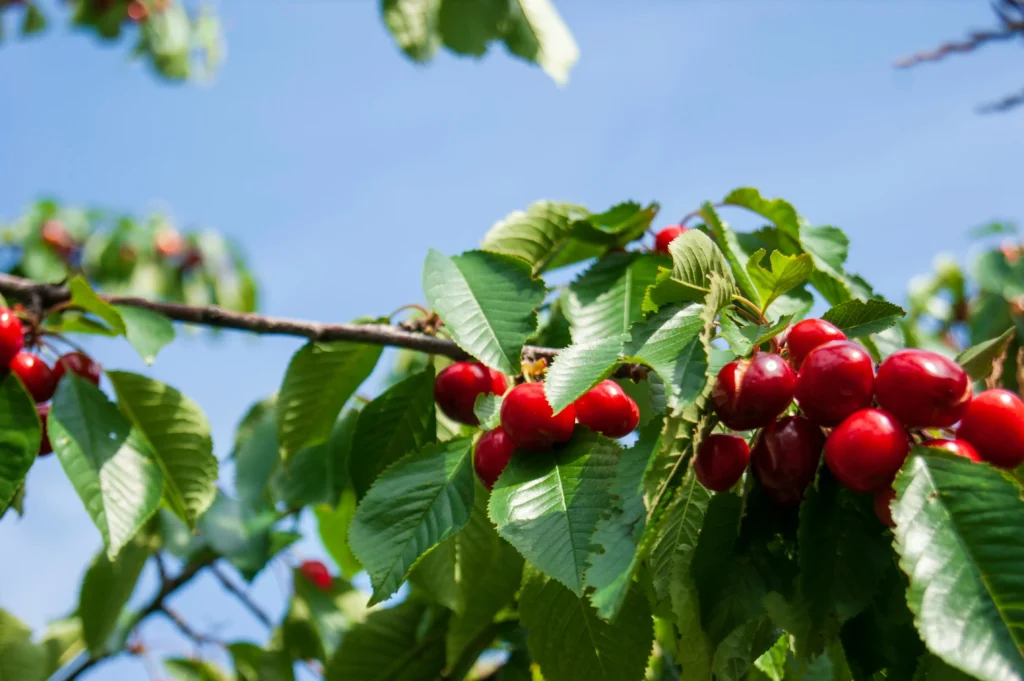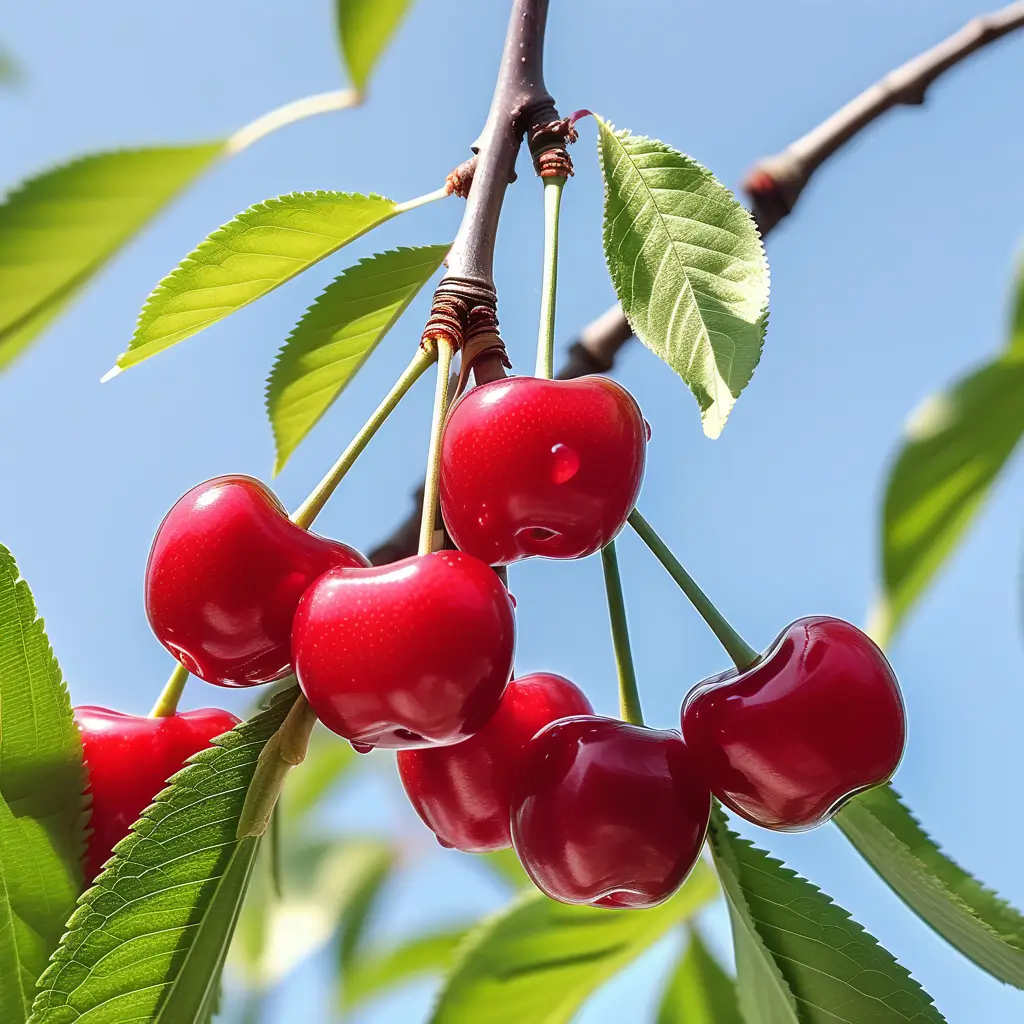Cherry trees are a beautiful and delicious addition to any home garden or orchard. When spring comes around and your cherry tree begins to bloom, you likely start daydreaming about all of the tasty pies, jams, and treats you’ll be able make.
But before you get too carried away with your cherry visions, rooted in lapins or stella variety, the logical question arises – just how many cherries can I expect my tree to produce for harvesting?
The yield you get from your cherry tree can vary based on a number of factors, which we’ll dig into shortly. But here are some general cherry tree yield statistics to use as a benchmark:
- Most standard sweet cherry trees produce an average of 50-100 lbs of cherries per year. Since cherries have an average weight of 5 grams, that translates to approximately 2,000 – 4,000 individual cherries per tree.
- Dwarf cherry trees yield a smaller harvest, averaging around 15-25 lbs (600-1,000 cherries) annually.
- Tart cherry trees tend to be more prolific producers than their sweet counterparts. Some Montmorency tart cherry trees can yield over 30 lbs in a single season!
Below those averages, a number of variables like tree maturity, climate, and pruning practices come into play. Keep reading as we examine what impacts cherry tree output and some best practices to help maximize your yearly cherry harvest.
What Type of Cherry Tree Do You Have?
The first factor impacting production is the type of cherry tree you are growing. There are two main types – sweet cherry trees and tart cherry trees:
- Sweet cherry trees produce the large, luscious Bing, Rainier, Black, and other eating cherry varieties. These trees tend to yield lower volumes than tart cherries, but their larger size makes them ideal for eating fresh or using in recipes. Common sweet cherry varieties like Bing or Rainier produce around 50-100 lbs per mature tree.
- Tart cherry trees yield the small, bright red Montmorency cherries used heavily in baking and cherry products. Their main graft rootstock is the ‘Montmorency’ cherry, which is a sour cherry variety that grows prolifically – yielding over 250 lbs per year in some mature trees.
So if max production is your main goal, tart cherries are likely the best bet. But sweet cherries give you more versatility for eating/recipes with their naturally sweeter flavor. When planting, consider space for planting multiple trees together since cross-pollination leads to increased yields in most cherry varieties.
Tree Maturity Impacts Cherry Production
Like any fruit tree, it takes time and growth before a young cherry tree reaches its full production potential. Here’s a look at yield based on tree age:
| Tree Age | Average Cherry Tree Yield |
| 1-3 years | Little to no harvest |
| 3-5 years | Light harvest, around 3-5 lbs |
| 6-8 years | 25-50% of full yield |
| 8+ years | Full mature production, possible with a successful graft. |
As shown above, you typically won’t see any sizable harvests until cherry trees are at least 5-8 years old. And full, peak production hits at around 8-10 years once the canopy has reached mature height and width.
So be prepared to patiently nurture your tree through those early years. But once established, a healthy cherry tree can keep producing its bountiful harvests for decades to come. Some standard trees last over 50 years!
Climate and Growing Conditions

Cherry trees need adequate chill hours in winter (below 45°F) followed by a period of moderate warmth in spring to break dormancy and successfully fruit. This makes them ideal for most temperate climates in zones 5-9, considering enough shade and protection from frost. Areas with hot summers and controlled shade, avoiding frost, provide optimal conditions for the cherry trees.
Here are some yield-impacting factors based on climate:
- Sunlight: Cherry trees need at least 6 hours of direct, unfiltered sunlight per day during the growing season. Insufficient sunlight leads to reduced yields.
- Soil: Well-draining, nutrient-rich soil keeps trees healthy and productive. Poor soil stunts growth and harvest size.
- Chill hours: Most cherry trees need consistent winter chill hours <45°F to set fruit buds. Not enough chill time affects next season’s yield.
- Rain/humidity: Excess rain/humidity during bloom time reduces pollination rates and therefore fruit set. Yields suffer as a result.
Pay attention to these climate signals and tweak your practices as needed. Thinning out obstructing branches or foliage to improve sunlight exposure is one example. Amending soil, adding drainage, properly pruning, and pest management also helps overcome less-than-ideal conditions.
Pollination Needs for Cherry Trees
Most (but not all) cherry tree varieties are self-incompatible, meaning they cannot pollinate themselves. Their yield relies on cross-pollination from another variety of cherry tree blooming at the same time.
Natural wind and insect pollination carries the pollen between compatible cherry tree partners. Without it, fruit set is limited or non-existent for many cherry tree types.
Here are some standard compatible pollination pairings that set large, even yields:
- Bing cherry trees with Van, Rainier, or Black Tartarian pollinators
- Rainier cherry trees with Bing, Van, Lambert, or Black Tartarian partners
- Montmorency tart cherry trees (mostly self-fertile and grown on tough rootstock)
For best results, always consult specific variety pollination requirements before planting. Then intersperse compatible trees within 25 feet of each other if possible.
Pruning Maximizes Cherry Tree Yield
Pruning is essential for controlling tree height/spread, improving access to sunlight, and balancing vegetative (leaf/branch) vs. fruit growth. The right pruning stimulates increased cherry yields over time.
Follow these tips for yield-boosting cherry tree pruning:
- Prune annually during dormancy to remove damaged/diseased wood and improve structure
- Use thinning cuts to open the canopy rather than heading cuts
- Focus on inward-facing branches and water sprouts which block light
- Space scaffold branches evenly up the central leader
- Don’t allow branches to overlap to improve air circulation
- Remove sucker growth around base to direct nutrients upwards
Done properly, pruning removes energy-wasting vegetation and shifts resources towards improved flowering and fruit production.
Can You Have Too Many Cherries? What to Do With a Bumper Crop
Once your cherry tree hits peak maturity after 8-10 years or more, yields over 100 lbs are definitely possible! And with average trees producing 4,000 cherries or more, you may find yourself with more cherries than you know what to do with during bumper harvest seasons.
While too many cherries is ultimately a good problem, here are some tips when faced with an exceptionally abundant cherry tree yield:
- Pick early and often: Harvesting cherries as soon as they ripen ensures the fruits don’t rot or attract pests. Pick every couple days during peak season for best quality.
- Enlist help picking: Have friends/family help pick and offer to share the bounty. More hands make lighter work.
- Preserve the harvest: Turn those extra cherries into jams, jellies, pie fillings, juices, and more that can last up to a year in the freezer. Cherry products make great gifts too!
- Prune strategically next year: Removing select branches that are over-fruitful helps rebalance energy and yield moving forward.
Cherry Tree Lifespan: How Long Do They Last?
With proper site selection, planting, care, and pruning, a healthy cherry tree can be incredibly long-lived in your yard or orchard.
- Most standard cherry trees produce for well over 30-50 years.
- Dwarf cherry trees have slightly shorter lifespans around 20-40 years.
- Some heirloom cherry trees in prime conditions bear fruit for 80+ years!
So while you wait for stem strength to develop over that very first 3 years, leading to the first cherry harvest that tests your patience, you’ll be rewarded with decades of bounty once your tree matures. Not a bad return on investment for caring for your backyard cherry producer!
Key Takeaways on Cherry Tree Yield
Hopefully this article gave you a helpful overview on estimating how many delicious cherries you can expect from the average cherry tree. Here are some key takeaways:
- Yield ranges widely based on tree type and maturity, but 50-100 lbs is average for a full-grown sweet cherry tree.
- Tart Montmorency cherries are heavier producers, sometimes yielding over 250 lbs per mature tree.
- Maximize harvests by selecting compatible pollinator tree partners and using proper annual pruning techniques.
- With ideal growing conditions, most standard cherry trees continue producing for over 30 years.
If you found this info helpful and are planning to add a cherry tree to your yard, first confirm pollinizer pairings and chilling hour requirements for your climate zone. Focus on providing adequate sunlight, nutrient-rich soil, and spacing during those early growing years.
Once established, you’ll have a naturally bountiful fruit producer to enjoy for decades to come!
Conclusion
Caring for a cherry tree is a labor of love that requires patience and diligence – but your efforts will be rewarded. When your tree matures, be prepared for an abundant harvest!
With adequate net protection, a mature, well-cared for cherry tree with strong rootstock can produce over 4,000 cherries each season for decades to come. Just imagine filling basket after basket with sweet, juicy cherries straight from your own backyard.
The effort to properly plant, establish, tend, prune and protect your cherry trees will pay off down the road. In just a few short years, you’ll have a naturally productive source of summer delight.
So commit now to nurturing your cherry trees. With some sweat equity and perseverance through those initial vacant years, you’ll soon be reveling in summer days filled with cherry goodness!
